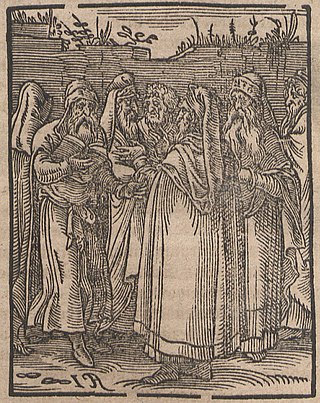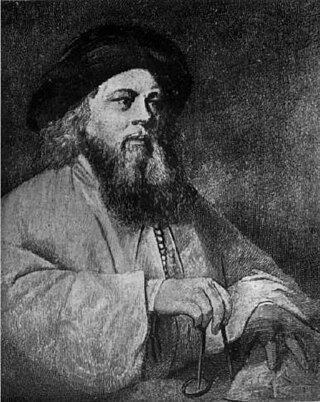
Kabbalah or Kabbala is an esoteric method, discipline and school of thought in Jewish mysticism. A traditional Kabbalist is called a Mekubbal. The definition of Kabbalah varies according to the tradition and aims of those following it, from its origin in medieval Judaism to its later adaptations in Western esotericism. Jewish Kabbalah is a set of esoteric teachings meant to explain the relationship between the unchanging, eternal God—the mysterious Ein Sof —and the mortal, finite universe. It forms the foundation of mystical religious interpretations within Judaism.

Jewish philosophy includes all philosophy carried out by Jews, or in relation to the religion of Judaism. Until modern Haskalah and Jewish emancipation, Jewish philosophy was preoccupied with attempts to reconcile coherent new ideas into the tradition of Rabbinic Judaism, thus organizing emergent ideas that are not necessarily Jewish into a uniquely Jewish scholastic framework and world-view. With their acceptance into modern society, Jews with secular educations embraced or developed entirely new philosophies to meet the demands of the world in which they now found themselves.

Isaac ben Solomon Luria Ashkenazi, commonly known in Jewish religious circles as "Ha'ARI", "Ha'ARI Hakadosh" or "ARIZaL", was a leading rabbi and Jewish mystic in the community of Safed in the Galilee region of Ottoman Syria, now Israel. He is considered the father of contemporary Kabbalah, his teachings being referred to as Lurianic Kabbalah. He is sometimes known as the Ari in English.
The Dardaim or Dor Daim, are adherents of the Dor Deah movement in Orthodox Judaism. That movement took its name in 1912 in Yemen under Rabbi Yiḥyah Qafiḥ, and had its own network of synagogues and schools, although, in actuality, the movement existed long before that name had been coined for it. According to ethnographer and historian, Shelomo Dov Goitein, author and historiographer, Hayyim Habshush had been a member of this movement before it had been given the name Dor Deah, writing, “...He and his friends, partly under European influence, but driven mainly by developments among the Yemenite Jews themselves, formed a group who ardently opposed all those forces of mysticism, superstition and fatalism which were then so prevalent in the country and strove for exact knowledge and independent thought, and the application of both to life.” It was only some years later, when Rabbi Yihya Qafih became the headmaster of the new Jewish school in Sana'a built by the Ottoman Turks and where he wanted to introduce a new curriculum in the school whereby boys would also learn arithmetic and the rudiments of the Arabic and Turkish languages that Rabbi Yihya Yitzhak Halevi gave to Rabbi Qafih's movement the name Daradʻah, a word which is an Arabic broken plural made-up of the Hebrew words Dör Deʻoh, and which means "Generation of Knowledge."
Academic study of Jewish mysticism, especially since Gershom Scholem's Major Trends in Jewish Mysticism (1941), draws distinctions between different forms of mysticism which were practiced in different eras of Jewish history. Of these, Kabbalah, which emerged in 12th-century southwestern Europe, is the most well known, but it is not the only typological form, nor was it the first form which emerged. Among the previous forms were Merkabah mysticism, and Ashkenazi Hasidim around the time of the emergence of Kabbalah.
Sha'ar ha Gilgulim is a kabbalistic work on Gilgul, the concept of reincarnation put together by Rabbi Hayyim Vital who recorded the teachings of his master Itzhak Luria in the 16th century CE.
Ibbur, is one of the transmigration forms of the soul and has similarities with Gilgul neshamot. Ibbur is always good or positive, while dybbuk, is negative. Ibbur is the most positive form of possession, and the most complicated. It happens when a righteous soul decides to occupy a living person's body for a time, and joins, or spiritually "impregnates" the existing soul. Ibbur is always temporary, and the living person may or may not know that it has taken place. Often the living person has graciously given consent for the Ibbur. The reason for Ibbur is always benevolent—the departed soul wishes to complete an important task, to fulfil a promise, or to perform a mitzvah that can only be accomplished in the flesh. In Lurianic Kabbalah, ibbur occurs when an incomplete soul which cannot achieve tikun is completed by the addition of the soul of a tzadik, or spiritual master. Luria believed this to be possible even whilst the possessor was still alive.

The Idra, is a Kabbalistic work included in printings of the Zohar, and was probably written and appended to the main body of the Zohar at a later date. Contemporary scholars believe the Idra dates to the third generation of Zoharic literature, which produced also the Tikunei haZohar, the Ra'aya Mehemna, and other Zoharic material. The main body of the Zohar, or guf ha-zohar, dates to the second generation of Zoharic material.
Hayyim ben Joseph Vital was a rabbi in Safed and the foremost disciple of Isaac Luria. He recorded much of his master's teachings. After Vital's death, his writings began to spread and led to a "powerful impact on various circles throughout the Jewish world."

Jewish meditation includes practices of settling the mind, introspection, visualization, emotional insight, contemplation of divine names, or concentration on philosophical, ethical or mystical ideas. Meditation may accompany unstructured, personal Jewish prayer, may be part of structured Jewish services, or may be separate from prayer practices. Jewish mystics have viewed meditation as leading to devekut. Hebrew terms for meditation include hitbodedut or hitbonenut/hisbonenus ("contemplation").
Cabala (alternately Kabbala(h) or Qabala(h)) may refer to one of several systems of mysticism:
Lurianic Kabbalah is a school of kabbalah named after Isaac Luria (1534–1572), the Jewish rabbi who developed it. Lurianic Kabbalah gave a seminal new account of Kabbalistic thought that its followers synthesised with, and read into, the earlier Kabbalah of the Zohar that had disseminated in Medieval circles.
Yeridat ha-dorot, meaning literally "the decline of the generations", or nitkatnu ha-dorot, meaning "the diminution of the generations", is a concept in classical Rabbinic Judaism and contemporary Orthodox Judaism expressing a belief in the intellectual inferiority of subsequent, and contemporary Torah scholarship and spirituality in comparison to that of the past. It is held to apply to the transmission of the "Revealed" aspects of Torah study, embodied in the legal and homiletic Talmud, and other mainstream rabbinic literature scholarship. Its reasoning derives from the weaker claim to authoritative traditional interpretation of scripture, in later stages of a lengthening historical chain of transmission from the original revelation of the Torah at Mount Sinai, and the codification of the Oral Torah in the Talmud. This idea provides the basis to the designated Rabbinic Eras from the Tannaim and Amoraim of the Talmud, to the subsequent Gaonim, Rishonim and Acharonim. Additionally, it has an extra metaphysical explanation in Kabbalah, regarding lower levels of souls in succeeding generations.
The primary texts of Kabbalah were allegedly once part of an ongoing oral tradition. The written texts are obscure and difficult for readers who are unfamiliar with Jewish spirituality which assumes extensive knowledge of the Tanakh, Midrash and halakha.
Practical Kabbalah in historical Judaism, is a branch of the Jewish mystical tradition that concerns the use of magic. It was considered permitted white magic by its practitioners, reserved for the elite, who could separate its spiritual source from Qliphoth realms of evil if performed under circumstances that were holy (Q-D-Š) and pure, tumah and taharah. The concern of overstepping Judaism's strong prohibitions of impure magic ensured it remained a minor tradition in Jewish history. Its teachings include the use of Divine and angelic names for amulets and incantations.
Divine providence is discussed throughout rabbinic literature, by the classical Jewish philosophers, and by the tradition of Jewish mysticism.
Ayin is an important concept in Kabbalah and Hasidic philosophy. It is contrasted with the term Yesh. According to kabbalistic teachings, before the universe was created there was only Ayin, and the first manifest Sephirah, Chochmah (Wisdom), "comes into being out of Ayin." In this context, the sephirah Keter, the Divine will, is the intermediary between the Divine Infinity and Chochmah. Because Keter is a supreme revelation of the Ohr Ein Sof, transcending the manifest sephirot, it is sometimes excluded from them.
Yichudim is a specific form of Jewish meditation in Kabbalistic Jewish mysticism, especially denoting the complete meditative method developed by Isaac Luria (1534–1572). The term Yichud is found in Halakha, denoting male-female "seclusion". In the esoteric anthropomorphism in Kabbalah, Yichudim denote unifications between male and female Divine aspects in the supernal sephirot.

A Baal Shem was a historical Jewish practitioner of Practical Kabbalah and supposed miracle worker. Employing the names of God, angels, Satan and other spirits, Baalei Shem are claimed to heal, enact miracles, perform exorcisms, treat various health issues, curb epidemics, protect people from disaster due to fire, robbery or the evil eye, foresee the future, decipher dreams, and bless those who sought his powers.





